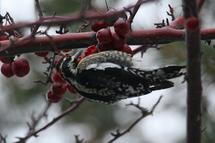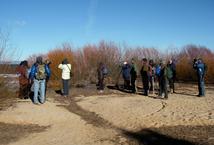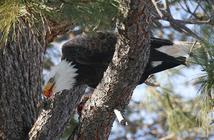saveourplanetearth.com
Call us: (775) 831-1331
Christmas Bird Count
Birders, grab your binoculars. The annual Christmas Bird Count (CBC), sponsored for over one hundred years by the National Audubon Society, is upon us.
The 115th Annual Audubon CBC will take place beginning December 14 and runs through January 5, 2015. The longest running Citizen Science survey in the world, the Christmas Bird Count provides critical data on avian population trends.
The Tahoe Institute for Natural Science (TINS) makes it easy for the everyday citizen to participate by functioning as the count coordinator for the local circle here at Lake Tahoe, which will take place Monday, December 15.
Will Richardson, TINS co-founder, has coordinated the South Lake Tahoe CBC since 2004. This year, AmeriCorps volunteer and Outreach Manager at TINS, Ruby Lyon, is assisting in coordinating the effort to bring the count to fruition at South Lake Tahoe.
Volunteers will meet at the Alpina Coffee Café on Emerald Bay Road at 8 a.m. on Monday, December 15. After an initial period of instruction and group observation, participants will split into smaller groups and will collectively cover an area 15 miles in diameter. At the end of the day, the group will reconvene and swap stories and notes.
Don’t worry if you can’t tell a wren from a robin, you will be paired with someone who can. Teams are typically a mixture of volunteers with varying degrees of experience. Each person is a set of eyes and can add value to the team, no matter what birding experience they have.
Plan on a day in the field, which for the South Lake Tahoe event, is a 7.5 mile radius circle centered at the mouth of the Upper Truckee River. Dress in layers, be sure to don warm boots; bring your binoculars, a camera if desired, notebook and field guide, a lunch and your enthusiasm for birds and wildlife.
The count coordinator is responsible for compiling and submitting the data to the Audubon Society. Once established, the circle remains where it is for subsequent counts.
The counts are conducted for a full eight hours in daylight with at least 10 observers. Some circles, in larger areas, may cover a 24-hour period and have dozens of observers. People who can’t be out of doors can participate by observing backyard feeders that exist within the counting circle.
Those who choose to participate will be rewarded with the satisfaction of providing valuable data to bird conservationists, of having spent an entire day outside observing nature, experiencing the warmth of the camaraderie of a group of nature enthusiasts, and perhaps with the sighting of a bird they haven’t seen before.
Birds observed in past counts include the American bald eagle, rough-legged hawk, Northern shrike and a variety of waterfowl. Some of the birds recorded are birds that are only or mainly seen in the wintertime in this area.
In 2008, observers were fortunate to spot three bald eagles congregated in one tree. Generally 60-80 different species are recorded. Who knows what treasures will be discovered during this year’s count – you don’t want to miss it.
The first Christmas Bird Count occurred in the year 1900 and was the idea of ornithologist Frank Chapman, who noticed that during the holidays, there was an excessive amount of hunting of birds. He was concerned that bird populations were declining, too many birds were ending up as decorations for hats and perhaps as holiday feasts, so he proposed, via his magazine, “Bird-Lore”, a Christmas Bird Census to be conducted on Christmas Day.
The first census involved 27 people but the tradition continued and eventually evolved into the CBC of today comprised of just over 2,400 circles and tens of thousands of observers.
Last year was spectacular in many areas of North America due to the irruption of snowy owls. An irruption is an unusually large group of birds found where they usually aren’t. The owls were found in abundance in the East and in the Great Lakes area beginning in November of 2013, believed to have been caused by a proliferation of lemmings in the Arctic the prior spring, leading to a breeding boom for the snowy owls.
We won’t be treated to a display of snowy owls in our area, but spotting a bald eagle would truly make my day. Join us in this event by contacting Ruby Lyon at TINS and pledge your participation for the Christmas Bird Count 2014.
Red-naped Sapsucker
American Bald Eagle
Volunteer searching for birds at Cove East, South Lake Tahoe
Photos courtesy of Will Richardson
Tahoe Institute for Natural Science





